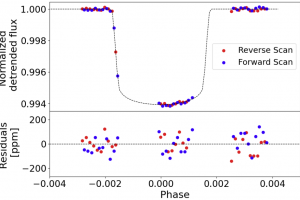Water or stellar activity? The study: “A reanalysis of the LHS 1140 b atmosphere observed with the Hubble Space Telescope” of A. Biagini (INAF-OAPA/UNIPA) appeared on MNRAS

To date, April 1st 2024, 74.4% of the 5602 confirmed exoplanets have been discovered through transit observations. This technique involves observing the imperceptible and periodic dimming of the luminosity of the central star during each transit of their planets in front of the star with respect to our line of sight. Furthermore, by comparing spectroscopic observations of the star outside of transit and during transit, it is possible to study the physical and chemical properties of the planet, thanks to the small amount of stellar light that passes through the planet’s atmosphere. It is mainly thanks to such techniques that we are able to characterize the atmospheres of such distant worlds.
LHS 1140 is a small star of spectral type M4.5, with an effective temperature of about 3100-3200 K and a mass of 0.184 solar masses, located just 41.2 light years from the Solar System. This star hosts the super-Earth LHS 1140 b, which has a mass of 5.6 Earth masses and a radius of 1.7 Earth radii. The planet orbits at a distance of 0.095 astronomical units from the star (1 astronomical unit being the mean distance between Earth and the Sun). At such a close distance from its star, LHS 1140 b is situated close to the habitable zone of the star, which is the range of distances at which an Earth-like planet can be sufficiently warm to support liquid water on its surface.
In-transit spectroscopic observations conducted with the Hubble Space Telescope (HST) and published in 2021 have suggested the presence of water in the atmosphere of LHS 1140 b. However, the discovery has been uncertain due to the potential influence of stellar magnetic activity, particularly the presence of photospheric spots. A team of researchers led by astronomer A. Biagini (INAF – Astronomical Observatory of Palermo and University of Palermo) analyzed out-of-transit HST observations of LHS 1140 to assess the level of stellar magnetic activity. The analysis revealed that the magnetic activity of LHS 1140 is relatively low, making it unlikely that the signal observed in 2021 was due to stellar spots. The researchers also simulated future observations of LHS 1140 b using the James Webb Space Telescope and the future European Space Agency satellite Ariel, planned for launch in 2029, demonstrating that both observatories will be capable of confirming the presence of water in the atmosphere of LHS 1140 b. The study is detailed in the paper “A reanalysis of the LHS 1140 b atmosphere observed with the Hubble Space Telescope“, recently published in The Monthly Notices of the Royal Astronomical Society. The list of coauthors includes astronomers G. Cracchiolo, A. Petralia, J. Maldonado, C. Di Maio, and G. Micela of the INAF – Astronomical Observatory of Palermo.
The cover image (click here to view it in its entirety) depicts a transit of LHS 1140 b.
Mario Giuseppe Guarcello ( follow mariospiegacose) ( mariospiegacose) ( follow mariospiegacose)
Follow the Astronomical Observatory of Palermo on Facebok and on Instagram
Subscribe the Youtube channel of the Astronomical Observatory of Palermo
